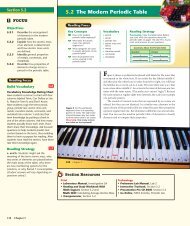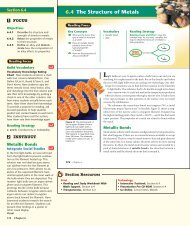26.2 Stars
26.2 Stars
26.2 Stars
You also want an ePaper? Increase the reach of your titles
YUMPU automatically turns print PDFs into web optimized ePapers that Google loves.
If you move away from a street light or a star, it<br />
shines just as brightly as before—but to you it<br />
appears fainter. Absolute brightness is how bright a<br />
star really is. A star’s absolute brightness is a characteristic<br />
of the star and does not depend on how far it<br />
is from Earth. You can calculate a star’s absolute<br />
brightness if you know its distance from Earth and<br />
its apparent brightness.<br />
Size and Mass Once astronomers know a star’s<br />
temperature and absolute brightness, they can estimate<br />
its diameter and then calculate its volume.<br />
However, there is no direct way of finding the mass of<br />
an isolated star. Instead, astronomers are able to calculate<br />
the masses of many stars by observing the<br />
gravitational interaction of stars that occur in pairs.<br />
From such observations, astronomers have determined<br />
that, for most stars, there is a relationship<br />
between mass and absolute brightness. Astronomers<br />
have found that many stars are similar to the sun in<br />
size and mass.<br />
How can astronomers determine a star’s mass?<br />
Composition A spectrograph is an instrument that spreads light<br />
from a hot glowing object, such as a light bulb or a star, into a spectrum.<br />
Astronomers can use spectrographs to identify the various<br />
elements in a star’s atmosphere.<br />
Each star has its own spectrum. The elements within a star’s atmosphere<br />
absorb light from the star’s photosphere. Each element absorbs<br />
light of different wavelengths, removing these wavelengths from the<br />
star’s continuous spectrum. The result is a bright spectrum, such as<br />
the one shown in Figure 12. It contains a set of dark lines called<br />
absorption lines that show where light has been absorbed. Just as fingerprints<br />
can be used to identify a person, a star’s absorption lines can<br />
be used to identify different elements in the star.<br />
Absorption lines of most elements have been identified in<br />
the spectra of stars. Observations of such lines in many stars<br />
have shown that the composition of most stars is fairly similar.<br />
Most stars have a chemical makeup that is similar to the sun,<br />
with hydrogen and helium together making up 96 to 99.9 percent<br />
of the star’s mass.<br />
Facts and Figures<br />
Discovery of Helium In 1868, a spectrometer<br />
was used for the first time to study the sun<br />
during a solar eclipse. The French astronomer<br />
Pierre Janssen analyzed the resulting spectrum<br />
and noticed that a bright yellow spectral line did<br />
not match any known elements. He proposed<br />
that the line was associated with a new element.<br />
Figure 11 These streetlights all<br />
have about the same absolute<br />
brightness. Inferring Why do<br />
the nearby streetlights appear<br />
brighter than the distant ones?<br />
Figure 12 This is the spectrum of<br />
a star. The dark absorption lines<br />
indicate the presence of various<br />
elements in the star.<br />
Exploring the Universe 837<br />
It was named helium, which stems from the<br />
Greek word helios, meaning “sun.” Helium, a<br />
light noble gas, is extremely difficult to detect<br />
on Earth. In 1895, Sir William Ramsay was finally<br />
able to demonstrate the presence of helium in<br />
ores by treating them with acids.<br />
Build Science Skills<br />
Communicating Results The Stefan-<br />
Boltzmann Law relates a star’s absolute<br />
brightness to its size and temperature.<br />
Written in equation form, the law states<br />
that L 4πR 2 sT 4 where L is luminosity<br />
(or absolute brightness), R is the radius<br />
of a star, s is a constant, and T is temperature.<br />
The equation can be used to<br />
determine a star’s size if its temperature<br />
and absolute brightness are known.<br />
Have students research and write brief<br />
reports about how scientists use the<br />
Stefan-Boltzmann Law.<br />
Verbal<br />
Integrate Chemistry<br />
L2<br />
L2<br />
Tell students that at the surface of stars<br />
with relatively low temperatures, atoms<br />
retain all of their electrons and radiate<br />
neutral, or normal, spectra. At very high<br />
temperatures, atoms collide and lose<br />
electrons and become thermally ionized.<br />
Ions have different spectra than atoms.<br />
Ask, How is it possible that two stars<br />
can have a similar composition, but<br />
radiate different spectra? (One of the<br />
stars is much hotter than the other.)<br />
Logical<br />
Answer to . . .<br />
Figure 10 Sirius A because it is blue<br />
Figure 11 The nearby streetlights<br />
have a greater apparent brightness.<br />
By observing the gravitational<br />
interaction of<br />
stars that appear in pairs, which led<br />
to the determination that mass and<br />
absolute brightness are related<br />
Exploring the Universe 837
















